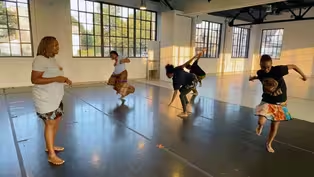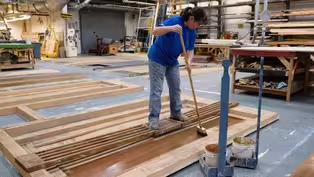Applause
Art Across Ohio: Urban Arts Space exhibition
Special | 6m 47sVideo has Closed Captions
Two artists in Columbus curate a show at the Ohio State University's Urban Arts Space
Let's make a move to Columbus to learn the ins and outs of putting an art exhibit on view. Here we spotlight the two artists who curated a show at the Ohio State University's Urban Arts Space Ajanaé Dawkins and Iyana Hill. This story is part of our special series - Behind the Scenes: Art Across Ohio.
Problems playing video? | Closed Captioning Feedback
Problems playing video? | Closed Captioning Feedback
Applause is a local public television program presented by Ideastream
Applause
Art Across Ohio: Urban Arts Space exhibition
Special | 6m 47sVideo has Closed Captions
Let's make a move to Columbus to learn the ins and outs of putting an art exhibit on view. Here we spotlight the two artists who curated a show at the Ohio State University's Urban Arts Space Ajanaé Dawkins and Iyana Hill. This story is part of our special series - Behind the Scenes: Art Across Ohio.
Problems playing video? | Closed Captioning Feedback
How to Watch Applause
Applause is available to stream on pbs.org and the free PBS App, available on iPhone, Apple TV, Android TV, Android smartphones, Amazon Fire TV, Amazon Fire Tablet, Roku, Samsung Smart TV, and Vizio.
Providing Support for PBS.org
Learn Moreabout PBS online sponsorshipMore from This Collection
Art Across Ohio: STEM Guitar Lab
Video has Closed Captions
The STEM Guitar Lab shows students and teachers alike the technology used to build electric guitars. (8m 2s)
Art Across Ohio: Djapo Cultural Arts Institute
Video has Closed Captions
Djapo Cultural Arts Institute in Cleveland creates new choreography. (8m 35s)
Art Across Ohio: Bowling Green State University Theatre
Video has Closed Captions
Kelly Mangan takes us behind the scenes of BGSU Theatre department. (5m 44s)
Providing Support for PBS.org
Learn Moreabout PBS online sponsorshipAll exhibitions are a process.
They're a different process for each one, but there definitely is a lot of work.
So every show I've worked on, there has at least been work, at least nine months in advance to get it to where it's at.
When you're putting together big events, there's always going to be a team.
And I think just in general, we have to work collaboratively.
So even when you think about whatever happened before this exhibition, the artists, they work with different people to even get to the point that they are in the install team or even like installing the exhibition.
There are nights and you might be here until two o 'clock in the morning.
But it's all for the enjoyment of the audience.
I am traditionally a poet.
And so a lot of me transitioning into this curatorial and exhibition work has been about trying to figure out how I will engage people through physical installations of my work.
And I actually really struggled trying to think visually first.
So when I was prepping for the exhibition I have coming up, "No One Teaches Us How to Be Daughters," I wrote into it.
So I wrote all of the different pieces.
I wrote them as poems.
And I was like, OK, how does this show up physically?
And some of them show up physically without any language.
But how does this show up physically in a space?
How would somebody engage with this?
How does this make somebody reflect, pause, insert themselves into a story?
How does this make them concerned with the stories of their own family or their own ideas of inheritance?
When approaching an exhibition and curating, I like to really think about how we can make the exhibition as immersive as possible, to really articulate what the topic is.
Especially in my case, a lot of the things that I deal with is blackness.
And blackness is such a complex topic.
And unless you're a part of that community, in particular, you might not understand.
I think oftentimes when it comes to exhibitions, we just think about sight and hearing.
But what happens when we bring together all the five senses and really make you feel like you're a part of the exhibition to help increase understanding.
"No One Teaches Us How to Be Daughters" starts with a story of a family member of mine who had gone missing.
And then I was really stuck on this idea of what it means to be missing and what that means as a black person, what that means as a black woman, what are all of the different ways that we go missing within ourselves.
So, again, just this idea, one single idea that is like freaking itself into a million different ways.
And then it hits the visual piece after I've written into it.
"Tapestry: Narrating a New Thread," was the first exhibition we had at Urban Art Space that we were able to have a hand in and I was able to place where everybody went.
Really considering flow, regardless of all the pieces are in the same space, it's not going to make sense.
There should be a story.
It can be a story.
So how do we think of curation as storytelling?
And then going into Air Press was so which was a very ambitious project.
Twenty seven artists.
It was like, I have to tell this story and I have to immerse everybody in this story.
And from there, it's just navigating, working with different artists, working with different organizations, having a vision.
And then this past year, working with other people to help their vision show.
I think so much about the folks who came before me.
For me, that's mostly specifically the women.
But I think so much about lineage and the value of the stories of people who come before me.
And so one of the things that I hope for is that people might have a process of reflecting on their own and maybe having their own kind of investment in the preservation of stories of people they might still have access to and of those embodied archives, especially because I think history and retelling is so fickle.
And so there are some things that are only accessible for you.
And if they are not archived and they are not preserved, they will be lost.
Some things are preserved through oral storytelling.
But that feels especially important to me as a black person is to be in charge of like like actual documenting and archival of my natural lineage.
So I hope that regardless of how folks identify that they might have a vested interest in preserving stories of folks around them.
You can't approach each show the same.
Every show is different.
Every vision is different.
Every... there's a different story each show.
So really sitting back and understanding what that exhibition statement is, what the purpose is, the vision and then going from there.
I think that has been the biggest lesson.
The most rewarding thing about doing this work is to really see the impact it can have on the artists in the show, on the community that's viewing the show or in some cases, like with like Ajanae or Eris helping their vision come to light.
I really enjoy helping.
I enjoy fitting together shows, which for me are reflective of a certain experience in the culture.
I think the reactions I enjoy the most are children's because I remember being a kid and going to art shows.
I'm like, wow.
But like I can only imagine coming into an immersive space when I was a child.
So seeing the children's reactions, that's my favorite part about it.
Support for PBS provided by:
Applause is a local public television program presented by Ideastream














